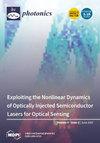Impact of Imbalanced Modulation on Security of Continuous-Variable Measurement-Device-Independent Quantum Key Distribution
IF 2.1
4区 物理与天体物理
Q2 OPTICS
引用次数: 0
Abstract
Continuous variable measurement-device-independent quantum key distribution (CV-MDI-QKD) removes all known or unknown side-channel attacks on detectors. However, it is difficult to fully implement assumptions in the security demonstration model, which leads to potential security vulnerabilities inevitably existing in the practical system. In this paper, we explore the impact of imbalanced modulation at transmitters on the security of the CV-MDI-QKD system mainly using a coherent state and squeezed state under symmetric and asymmetric distances. Assuming two different modulation topologies of senders, we propose a generalized theoretical scheme and evaluate the key parameter achievable of the protocol with the mechanism of imbalanced modulation. The presented results show that imbalanced modulation can achieve a relatively nonlinearly higher secret key rate and transmission distances than the previous protocol which is the balanced modulation variance used by transmitters. The advantage of imbalanced modulation is demonstrated for the system key parameter estimation using numerical simulation under different situations. In addition, the consequences indicate the importance of imbalanced modulation on the performance of CV-MDI-QKD protocol and provide a theoretical framework for experimental implementation as well as the optimal modulated mode.不平衡调制对连续可变测量-设备无关量子密钥分发安全性的影响
与测量设备无关的连续可变量子密钥分配(CV-MDI-QKD)可消除对探测器的所有已知或未知侧信道攻击。然而,安全演示模型中的假设很难完全实现,这导致实际系统中不可避免地存在潜在的安全漏洞。本文主要利用对称和非对称距离下的相干态和挤压态,探讨发射机不平衡调制对 CV-MDI-QKD 系统安全性的影响。假设发送方有两种不同的调制拓扑结构,我们提出了一种广义的理论方案,并评估了该协议在不平衡调制机制下可实现的关键参数。结果表明,与之前的协议(即发送方使用的平衡调制方差)相比,不平衡调制可以实现相对非线性的更高密钥率和传输距离。在不同情况下,利用数值模拟对系统密钥参数进行估计,证明了不平衡调制的优势。此外,研究结果表明了不平衡调制对 CV-MDI-QKD 协议性能的重要性,并为实验实施和最佳调制模式提供了理论框架。
本文章由计算机程序翻译,如有差异,请以英文原文为准。
求助全文
约1分钟内获得全文
求助全文
来源期刊

Photonics
Physics and Astronomy-Instrumentation
CiteScore
2.60
自引率
20.80%
发文量
817
审稿时长
8 weeks
期刊介绍:
Photonics (ISSN 2304-6732) aims at a fast turn around time for peer-reviewing manuscripts and producing accepted articles. The online-only and open access nature of the journal will allow for a speedy and wide circulation of your research as well as review articles. We aim at establishing Photonics as a leading venue for publishing high impact fundamental research but also applications of optics and photonics. The journal particularly welcomes both theoretical (simulation) and experimental research. Our aim is to encourage scientists to publish their experimental and theoretical results in as much detail as possible. There is no restriction on the length of the papers. The full experimental details must be provided so that the results can be reproduced. Electronic files and software regarding the full details of the calculation and experimental procedure, if unable to be published in a normal way, can be deposited as supplementary material.
 求助内容:
求助内容: 应助结果提醒方式:
应助结果提醒方式:


